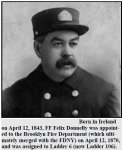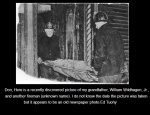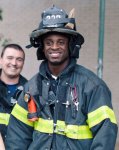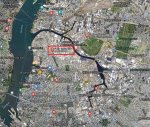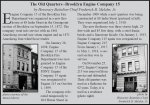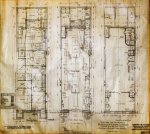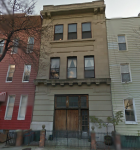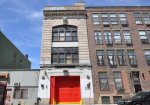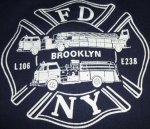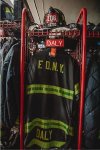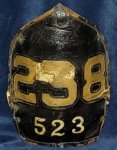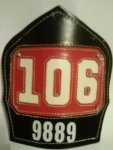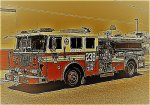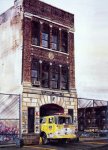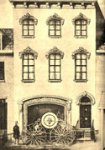ENGINE 238/LADDER 106/FOAM TENDER FIREHOUSE 205 GREENPOINT AVENUE GREENPOINT, BROOKLYN DIVISION 11, BATTALION 28 “GUARDIANS OF GREENPOINT” "TILLER TRUCK"
GREENPOINT
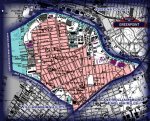 How It Got Its Name - Purchased in 1638 by the Dutch from the Indians, Greenpoint, along with Williamsburg, was part of the mid-17th-century town known as Bos-ijck (Bushwick), meaning "the wooden district." Brooklyn’s northernmost point was once covered in trees, hence "Green Point," now Greenpoint.
How It Got Its Name - Purchased in 1638 by the Dutch from the Indians, Greenpoint, along with Williamsburg, was part of the mid-17th-century town known as Bos-ijck (Bushwick), meaning "the wooden district." Brooklyn’s northernmost point was once covered in trees, hence "Green Point," now Greenpoint.
Greenpoint
Greenpoint is the northernmost neighborhood in the New York City borough of Brooklyn, in the U.S. state of New York. It is bordered on the southwest by Williamsburg at Bushwick Inlet Park and McCarren Park; on the southeast by the Brooklyn–Queens Expressway and East Williamsburg; on the north by Newtown Creek and the neighborhood of Long Island City in Queens; and on the west by the East River. The neighborhood has a large Polish immigrant and Polish-American community, containing many Polish restaurants, markets, and businesses, and it is often referred to as Little Poland.
Originally farmland – many of the farm owners' family names, such as Meserole (Messerole) and Calyer, are current street names – the residential core of Greenpoint was built on parcels divided during the 19th century, with rope factories and lumber yards lining the East River to the west, while the northeastern section along the Newtown Creek through East Williamsburg became an industrial maritime area.
Greenpoint has long held a reputation of being a working class and immigrant neighborhood, and it initially attracted families and workers with its abundance of factory jobs, heavy industry and manufacturing, and longshoreman or dock work. Since the early 2000s, a building boom in the neighborhood has made the neighborhood increasingly a center of nightlife and gentrification, and a 2005 rezoning enabled the construction of high density residential buildings on the East River waterfront. There have also been efforts to reclaim the rezoned East River waterfront for recreational use and also to extend a continuous promenade into the Newtown Creek area.
Police and crime
Greenpoint is patrolled by the 94th Precinct of the NYPD, located at 100 Meserole Avenue. The 94th Precinct ranked 50th safest out of 69 patrol areas for per-capita crime in 2010. As of 2018, with a non-fatal assault rate of 34 per 100,000 people, Greenpoint and Williamsburg's rate of violent crimes per capita is less than that of the city as a whole. The incarceration rate of 305 per 100,000 people is lower than that of the city as a whole.
The 94th Precinct has a lower crime rate than in the 1990s, with crimes across all categories having decreased by 72.9% between 1990 and 2018. The precinct reported 1 murder, 6 rapes, 63 robberies, 115 felony assaults, 141 burglaries, 535 grand larcenies, and 62 grand larcenies auto in 2018.
Fire safety
The New York City Fire Department (FDNY) operates two fire stations in Greenpoint.[62] Engine Co. 238/Ladder Co. 106 is located at 205 Greenpoint Avenue and serves most of the neighborhood.[63] The southern part of Greenpoint is served by Engine Co. 229/Ladder Co. 146, located at 75 Richardson Street.
Greenpoint, Brooklyn - Wikipedia
 The History of Greenpoint, Brooklyn: An Industrial-Strength Story
The History of Greenpoint, Brooklyn: An Industrial-Strength Story
 PODCAST The history of the Brooklyn neighborhood of Greenpoint and the oft-polluted Newtown Creek.
PODCAST The history of the Brooklyn neighborhood of Greenpoint and the oft-polluted Newtown Creek.
Greenpoint, Brooklyn, has a surprising history of both bucolic green pastures and rancid oil patches. Before the 19th century this corner of Brooklyn was owned by only a few families with farms (and the slaves that tended them).
But with the future borough of Brooklyn expanding at a great rate, Greenpoint (or Green Point, as they used to call it) could no longer remain private.
Industries like ship building and petroleum completely changed the character of Greenpoint’s waterfront, while its unique, alphabetically-named grid of streets held an extraordinary collection of townhouses.
By the late 19th century, Polish immigrants would move on the major avenues, developing a ‘Little Poland’ that still characterizes the neighborhood.
Today big changes are coming to Greenpoint thanks to new housing developments. How will these new arrivals fare next to the notoriously toxic
Newtown Creek, a body of water heavily abused by industry?
FEATURING: Charles Pratt, Margaret Wise Brown, Pat Benetar and the alarming smell of cinnamon toast!
A map of Greenpoint from an 1896 survey. A list of industries are marked along the waterfront including tanneries, rope and twine manufacturers, a glue factory, glass works and “Wissel’s Dead Animal Wharf.”
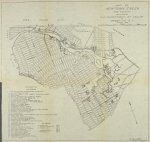
Courtesy New York Public LIbrary
Neziah Bliss, the ‘godfather’ of Greenpoint due to his marriage into the Meserole family and subsequent development of their former farm and shoreline property.

The USS Monitor, made at an iron works in Greenpoint, pictured here July 9, 1862, by Union photographer James F. Gibson.

Courtesy Library of Congress
An ad for Eberhard Faber pencils from the 1905 journal
Architect and Engineer.
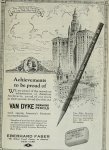
Internet Book Archive
Employees at the Eberhard Faber pencil company in Greenpoint, circa 1915, courtesy Brooklyn Historical Society

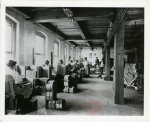
Courtesy Brooklyn Historical Society

Your standard view of Newtown Creek in the early 20th century.

Courtesy New York Public Library
One unusual house at 112 Milton Street.
The house is still there but, as part of the
Greenpoint Historic District, it’s no longer blue.
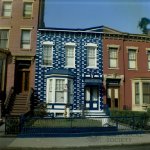
Courtesy Brooklyn Historical Society
The old Meserole house at 1000 Lorimer Street

Courtesy Brooklyn Historical Society
A very fanciful ‘place mat’ map of Greenpoint Brooklyn. I’m not sure what the original source for this is, but it’s courtesy
the Box Hotel.

A rather ghastly look at Newtown Creek in 1960, from Apollo Street looking towards the East River.
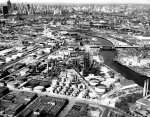
Courtesy Newtown Creek Alliance
Picture at top: Manhattan Avenue and Bedford Avenue
 The History of Greenpoint, Brooklyn: An Industrial-Strength Story - The Bowery Boys: New York City History (boweryboyshistory.com)
The History of Greenpoint, Brooklyn: An Industrial-Strength Story - The Bowery Boys: New York City History (boweryboyshistory.com)














